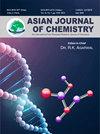Sequestration of Heavy Metals from Water by Aegle marmelos (Bael) Leaves as Promising Biomaterial: Kinetic and Equilibrium Studies
Q4 Chemistry
引用次数: 0
Abstract
Heavy metals abatement from polluted water through the use of green biosorbents is a growing research area due to its renewability and inexpensive. This study investigates the idea of utilizing Aegle marmelos (Bael) leaves as a biosorbent for the removal of heavy metal ions Cd(II), Pb(II) and Cr(VI) from simulated wastewater. The surface area, functionality, surface morphology and elemental analysis of biosorbent were analyzed by BET, FTIR, FE-SEM with EDX, respectively. Batch studies were done for biosorption of heavy metal ions. The maximum biosorption capacity of heavy metal ions were optimized by varying the pH (2-9), metal ions concentration (20-80 mg/L), biosorbent dose (0.02-0.2 g/L) and contact time (30-210 min). The Langmuir adsorption isotherms and pseudo-second order kinetics models were the most suitable for the biosorption of heavy metal ions and the maximum adsorption capacity was 11.85, 10.35 and 8.55 mg/g for Pb(II), Cd(II) and Cr(VI) heavy metals, respectively at optimized time 120 min. Thermodynamics studies revealed that biosorption of Pb(II), Cd(II) and Cr(VI) on A. marmelos biosorbent was exothermic and spontaneous in nature. Finally, the removal efficiency of A. marmelos biosorbent against the all three metals were found maximum for Pb(II) followed by Cd(II) and Cr(VI) due to the variations in hydration energy of these heavy metals.Aegle marmelos(桦树)叶作为有前途的生物材料对水中重金属的螯合作用:动力学和平衡研究
由于绿色生物吸附剂的可再生性和廉价性,通过使用绿色生物吸附剂去除污染水体中的重金属是一个不断发展的研究领域。本研究探讨了利用贻贝叶作为生物吸附剂去除模拟废水中重金属离子 Cd(II)、Pb(II) 和 Cr(VI) 的想法。生物吸附剂的表面积、功能性、表面形态和元素分析分别通过 BET、傅立叶变换红外光谱、FE-SEM 和 EDX 进行了分析。对重金属离子的生物吸附进行了批量研究。通过改变 pH 值(2-9)、金属离子浓度(20-80 mg/L)、生物吸附剂剂量(0.02-0.2 g/L)和接触时间(30-210 分钟),优化了重金属离子的最大生物吸附容量。朗缪尔吸附等温线和伪二阶动力学模型最适合重金属离子的生物吸附,在最佳吸附时间 120 分钟时,Pb(II)、Cd(II) 和 Cr(VI) 重金属的最大吸附容量分别为 11.85、10.35 和 8.55 mg/g。热力学研究表明,A. marmelos 生物吸附剂对铅(II)、镉(II)和铬(VI)的生物吸附是放热和自发的。最后,发现芒果树生物吸附剂对所有三种金属的去除率中,对铅(II)的去除率最高,其次是镉(II)和铬(VI),原因是这些重金属的水合能不同。
本文章由计算机程序翻译,如有差异,请以英文原文为准。
求助全文
约1分钟内获得全文
求助全文
来源期刊

Asian Journal of Chemistry
化学-化学综合
CiteScore
0.80
自引率
0.00%
发文量
229
审稿时长
4 months
期刊介绍:
Information not localized
 求助内容:
求助内容: 应助结果提醒方式:
应助结果提醒方式:


